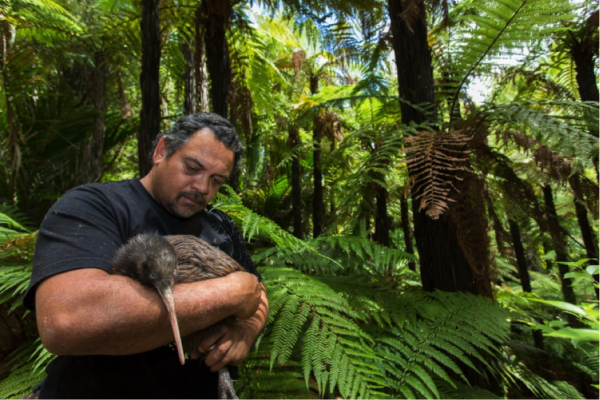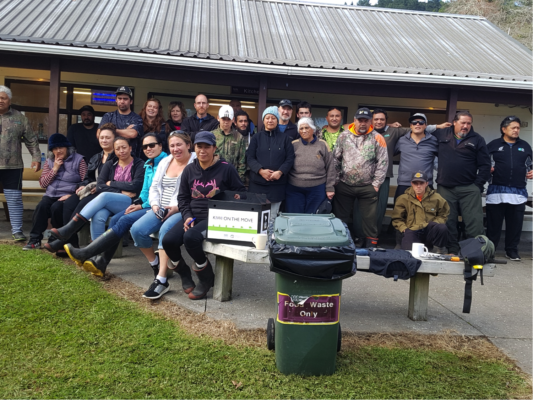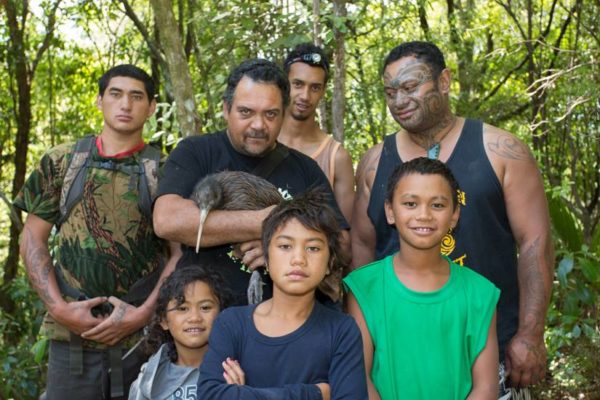Ian Tarei is Kiwi Project Manager for the Omataroa-Rangitaiki No 2 [Maori land] Trust and has been involved with the project since its beginning 10 years ago. But trapping predators to benefit kiwi in the Trust’s 540 hectare Puhikoko Reserve is only part of the work Ian does. His company, Omataroa Kaitiaki, is also quietly working to help local youth, teaching them trapping and bush skills and instilling a sense of guardianship – kaitiaki – for their local forests.

“I was trapping possums in the block for a living,” Ian says. “So when the kiwi programme started we were the guys on the ground. They asked if we wanted to be involved and I was keen to learn, so I learned how to catch kiwi and kiwi handling.”
Ian was involved in setting up the infrastructure for predator control – and he recruited some young helpers early on in the process.
“There were some mischievous young fellas, my nephews, 3-5 of them aged about 13 or 14. They got involved doing possums at weekends. Some of them are still involved, 10 years on. They’ve come a long way, learned kiwi handling and they’re still with me. Others, when they got to 17 or 18, they started getting interested in girls, alcohol…,” Ian says ruefully, “so there was a lot of chasing them up.”
While some of those ‘mischievous young fellas’ are no longer involved, they’ve learnt valuable bush skills along the way and Ian continues to encourage local youngsters to be guardians of their kiwi and forests. Children from kohanga-age on are learning to be kaitiaki. Many of the children are, in fact, beneficial owners of the Maori Trust land.
“One of the best days we’ve had was with 30 kids from the local hunting club,” says Ian. “They built kiwi houses and nest burrows.
Ian is, himself, a member of the local Omataroa Hunting Club, but admits that when the Kiwi Project started at Puhikoko 10 years ago, it took a long time to build a relationship and understanding with local hunters.

“There’s a big hunting population and the bush has been a food cupboard for generations,” he explains. “It feeds 8 or 9 marae when there’s a tangi etc. In the hunting season there’s deer and pigs. There’s no hunting except with permission and no dogs are allowed in the forest unless they’ve had kiwi aversion training.”
The wild pigs haven’t been slow to catch on.
“When the forest was closed to hunting the Puhikoko Reserve became a ‘pig pen’,” says Ian. “The pigs knew they were safe. Now when the pigs get out of control we have a cull weekend and invite hunters, experienced dogs that we can trust. We check the birds before and after the cull and they seem to be okay.”
Poaching is occasionally a problem, however.
“There’s some poaching goes on,” Ian admits, “It’s hard to stop, but most of the hunting club are very good. We work together. A lot of the hunters take ownership of the forest themselves. There’s a lot of support.”
Initially, with three years of funding from Nga Whenua Rahui for the kiwi programme, nine kiwi were caught and fitted with transmitters.
“Nick Gillingham caught one male,” Ian recalls, “then kiwi expert Lance Dew (who established the Kuaotunu Kiwi Sanctuary in 1996), caught another eight birds.”
Five of those birds incubated viable eggs every year, while one, perhaps an older bird, only ever produced one egg that was viable. One bird continued to be tracked with his transmitter for nine years.
Tracking the birds through their transmitters meant that their status (alive) and location could be monitored. Nests could be located and checked for incubation.
“At 25 days incubation we peg the nest,” Ian explains, “then at 60 days we retrieve the egg to be hatched and raised at Kiwi Encounter.”
Once they reach 1000g young kiwi return to their home forest. In recent years, with numbers growing, some have also been gifted to other kiwi conservation projects.

After the initial three years of funding, the Kiwi Project faced some lean years when they struggled to get enough funding support. At the time the Omataroa Rangitaiki No2 Trust was funding the kiwi project, Nga Whenua Rahui funded the pest control in Puhikoko Reserve and Rayonier Matariki funded the start of the outside buffer trapping.
That all changed after a visit from Morgan Cox of ‘Kiwis for kiwi’.
“Morgan made sure we were applying for funding.” Ian says. “He visited and saw we had a good programme, with good guys – but very little support. So he coordinated a meeting with Nga Whenua Rahui, Rayonier Forests, Bay of Plenty Regional Council and Whakatane Kiwi Trust. They all agreed that the project needed looking after and a stakeholder group was formed.”
Since then, things have got better and better for Omataroa’s Kiwi Project and everyone works together to contribute where they can.
“The Omataroa stake holder group developed a biodiversity management plan and a budget was written and everyone committed to that budget,” says Ian “Omataroa Rangitaiki No2 Trust fund 100% of the kiwi work, Nga Whenua Rahui fund 100% of the trapping inside the Puhikoko Reserve and Rayonier Forestry fund buffer trapping outside the periphery with 72 sponsored DOC 200 and DOC 250 traps and 15 cat traps. That has since grown to over 900 traps over 7777ha. ‘Kiwis for kiwi’ provide transmitters, support kiwi call surveys and provide support through Morgan Cox and the Bay of Plenty Regional Council help with things like mapping, small bird monitoring and pest plant control. Whakatane Kiwi Trust provide technical support and lend gear when it’s needed.”
The results speak for themselves.
“We’ve got 0% rat monitoring in the Puhikoko block,” says Ian, “And small bird numbers have exploded.”
Kiwi call surveys began at the main site, Puhikoko in 2010 and have recorded a growing number of calls. Nine sites were monitored and 38 birds detected in three nights of call monitoring. Call surveys were carried out there for three consecutive years, then surveying switched to a second smaller side of native forest on a peninsula and separated by a road from the main block. Three years of monitoring were carried out there in some fairly ‘rough’ terrain, with 61 male calls and 19 female calls recorded from 7 sites in the third year – giving an estimated guess of 15 pairs.
“This was a total surprise to us,” says Ian, “as we have never monitored any of our transmitted kiwi on that side of the block.”
Kiwi call monitoring returned to the main site this year and will continue there for two more years. In the 2017 count, weather conditions meant the survey was carried out over 2.5 nights rather than the full 3 nights. Nevertheless, 84 male and 41 female calls were recorded.
“Most birds don’t call till they’re three years old,” says Ian. “The call numbers mean that there are an estimated 50+ pairs in the area. And there’s kiwi sign throughout the forest and kiwi are seen throughout the forest at night on the roads and logging crews have been reporting sightings of kiwi during logging operations. It shows the plan is working.”
Ian is deeply appreciative of the support he and the team had in the early days from other kiwi conservationists who shared their knowledge.
“Jono and Paula Williams from Project Kiwi are awesome,” he says. “We were just learning and they invited us to the kiwi count at Coromandel. It was at this survey we met the Waikaremoana Hapu Restoration Trust. It was decided that if we held a survey they would come and support us. Ricki Winitana and Bob Waiwai from the Waikaremoana Hapu Restoration Trust along with Paula and Jono Williams and Morgan Cox taught us how to run a survey. This is our 7th survey and they have been to everyone. The surveys have been growing every year with a lot of different maori trust/iwi groups coming to learn about this kaupapa.”
Ian’s own leadership skills were recognised last year when Bridget Palmer from ‘Whakatane Kiwi Trust’ and Michele Impey from ‘Kiwis for kiwi’ nominated him for the ‘Kaitiaki Leadership Award’ at the Ministry of Environment’s Green Ribbon Awards. The award ceremony was held at Parliament and there were other impressive nominations, so Ian was both surprised and delighted when his name was announced as the winner.
“We did the hard yards so it’s good to be recognised,” Ian says. “The community, whanau… everybody won.”
Plans for the future include extending trapping beyond the forest, including onto privately owned farmland.
“There’s a big hole on a farm that boundaries the kiwi reserve and Sisams and Sons Ltd are okay with trapping there. We’ll supply the traps through funding from Kiwis for kiwi and they will pay for the maintenance of the traps,” Ian explains.
Another exciting plan, still at the discussion stage, is a proposal to extend the kaitiaki work with local children and youth into a sponsored ‘Kaitiaki Ranger’ programme at Te Kura O Te Teko. Currently local kohanga reo and school pupils take part in kiwi releases when young kiwi reach 1000g and are returned to the reserve. Rayonier Forest personnel recently visited the local school.
“They were blown away by the kids,” says Ian proudly. “They want to do more with them. The ‘Kaitiaki Ranger’ came from them.”
Ian has had further meetings with Rayonier forestry and is hopeful the project will go ahead.
“We’d get the kids involved in trap lines,” he says, “take them to Kiwi Encounter to see the kiwi chick raising process, get kids doing articles for the local paper…”
It would be a great experience for the children – and an excellent way to ensure that the Omataroa-Rangitaiki No 2 Trust’s next generation of beneficial owners are well prepared for their kaitiaki role.

